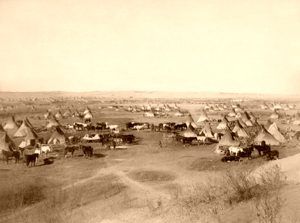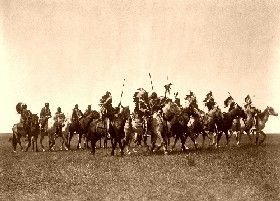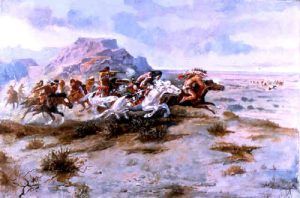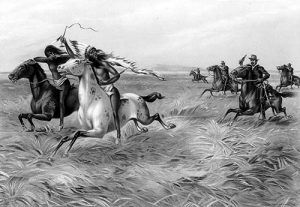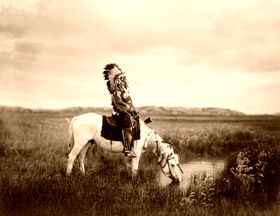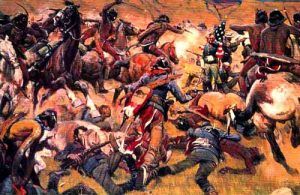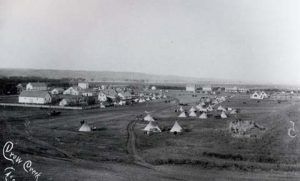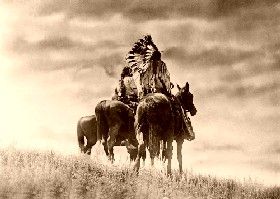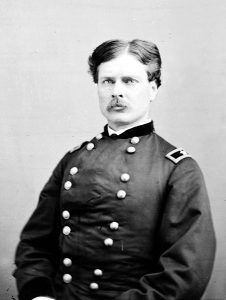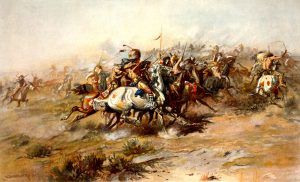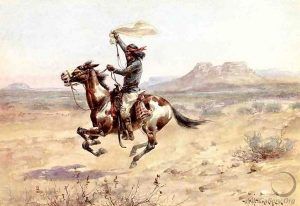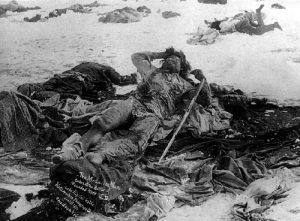By Emerson Hough in 1918
The land between the Missouri River and the Rockies, along the Great Plains and the high foothills, was crossed over and forgotten by the men who were forging on into farther countries, searching for lands where fortune was swift and easy. California, Oregon, all the early farming and timbering lands of the distant Northwest — lay far beyond the Plains, and as we have noted, they were sought for, even before gold was dreamed of upon the Pacific Slope.
So here, somewhere between the Missouri River and the Rockies, advancing, gaining and losing, changing a little more every decade — and at last so rapidly changed as to be outworn and abolished in one swift decade all its own.
This unsettled land so long held in small repute by the early Americans was, as we have pointed out, the buffalo range and the country of the Horse Indians — the Plains tribes who lived upon the buffalo.
For a long time, this Indian population held back the white settlements of Kansas, Nebraska, the Dakotas, Montana, Wyoming, and Colorado. But as men began to work farther and farther westward in search of homes in Oregon or quest for gold in California, Idaho, or Montana, the Indian question became serious.
Soon after the Civil War, the Army fell to the task of exterminating, or at least evicting, the savage tribes of this unvalued and unknown Middle West. This was a process not altogether simple. For a considerable time, the Indians themselves were able to offer very effective resistance to the enterprise. They were accustomed to living in that country and did not need to bring in their own supplies; hence, the Army fought them at a certain disadvantage. The Army had to learn to become half-Indian before fighting the Indians on anything like even terms. We did not seem to have coveted the lands in the first Indian-fighting days; we fought rather for the trails than the soil. The Indians had lived there all their lives, conquered their environment, and were happy in it. They made a bitter fight, and will they be blamed for doing so?
The greatest of our Indian wars have occurred since our own Civil War, and perhaps the most notable of all the battles are those fought on the old cow range — in the land of our last frontier. We do not lack abundant records of this time in our history. Soon after the Civil War, the railroads began edging out into the Plains. Besides many new settlers, they brought an abundance of chroniclers, historians, and writers of hectic fiction or supposed fact. Many books came out at this time in our history, most of which were accepted as truth. That was when we set up as Wild West heroes rough skin-clad hunters and so-called scouts, each of whom was allowed to tell his own story and have it accepted at par.
In fact, when the Army succeeded in subduing the last of the Indian tribes on the buffalo range, most of our Wild West history, at least so far as concerned the boldest adventure, was a thing of the past. It was easy to write of a past that everyone was now too new, ignorant, or too critically busy to remember.
Even as early as 1866, Colonel Marcy, an experienced army officer and Indian fighter, wrote about a vanishing phase of American life. In his Army “Life on the Border,” he said:
“I have been persuaded by many friends that the contents of the book which is herewith presented to the public are not without value as records of a fast-vanishing age, and as truthful sketches of men of various races whose memory will shortly depend only on romance unless someone who knew them shall undertake to leave outlines of their peculiar characteristics… I am persuaded that excuse may be found in the simple fact that all these peoples of my description — men, living conditions, races of aboriginal inhabitants, and adventurous hunters and pioneers — are passing away.
In a few years more, the prairie will be transformed into farms. The mountain ravines will be the abodes of busy manufacturers, and the gigantic power of American civilization will have taken possession of the land from the great river of the West to the very shores of the Pacific… The world is fast filling up.
I trust I am not in error when I venture to place some value, however small, on everything that goes to form the truthful history of a condition of men incident to the advances of civilization over the continent — a condition which forms peculiar types of character, breeds remarkable developments of human nature — a condition also which can hardly again exist on this or any other continent, and which has, therefore, a special value in the sum of human history.”
Such words bespeak a large and dignified point of view. No one who follows Marcy’s pages can close them with anything but respect and admiration. In books such as this, we may find something about the last stages of the clearing of the frontier.
Even in Marcy’s time, the question of our Government’s Indian policy was mooted. As an Army officer, he looked at the matter philosophically, but his estimate of conditions was exact. Long ago, as he wrote, his conclusions were such as might have been given forty years later.
“The limits of their accustomed range are rapidly contracting, and their means of subsistence undergoing a corresponding diminution. The white man is advancing rapidly upon all sides of them, and they are forced to give way to his encroachments. The time is not far distant when the buffalo will become extinct, and they will then be compelled to adopt some other mode of life than the chase for a subsistence… No man will quietly submit to starvation when food is within his reach, and if he cannot obtain it honestly, he will steal it or take it by force. If therefore, we do not induce them to engage in agricultural avocations, we shall in a few years have before us the alternative of exterminating them or fighting them perpetually. That they are ultimately destined for extinction does not, in my mind, admit of a doubt. For the reasons above mentioned, it may at first be necessary for our government to assert its authority over them by a prompt and vigorous exercise of the military arm… The tendency of the policy I have indicated will be to assemble these people in communities where they will be more readily controlled, and I predict from it the most gratifying results.”
Another well-informed army officer, Colonel Richard Dodge, himself a hunter, a trailer, and a rider able to compete with the savages in their own fields, penetrated to the heart of the Indian problem when he wrote:
“The conception of Indian character is almost impossible to a man who has passed the greater portion of his life surrounded by the influences of a cultivated, refined, and moral society… The truth is simply too shocking, and the revolted mind takes refuge in disbelief as the less painful horn of the dilemma. As a first step toward an understanding of his character, we must get at his standpoint of morality. As a child, he is not brought up…From the dawn of intelligence, his own will is his law. There is no right and no wrong to him… No dread of punishment restrains him from any act that boyish fun or fury may prompt. No lessons inculcating the beauty and sure reward of goodness or the hideousness and certain punishment of vice are ever wasted on him. The men by whom he is surrounded and to whom he looks as models for his future life are great and renowned just in proportion to their ferocity, to the scalps they have taken, or the thefts they have committed. His earliest boyish memory is probably a dance of rejoicing over the scalps of strangers, all of whom he is taught to regard as enemies. The lessons of his mother awaken only a desire to take his place as soon as possible in fight and foray. The instruction of his father is only such as is calculated to fit him best to act a prominent part in the chase, in theft, and in murder… Virtue, morality, generosity, honor are words not only absolutely without significance to him but are not accurately translatable, into any Indian language on the Plains.”
These are sterner, less kindly, less philosophic words than Marcy’s, but they keenly outline the Army’s duty on the frontier. We made treaties with the Indians and broke them. In turn, men such as these ignorant savages might well be expected to break their treaties also, and they did. Unhappily, our Indian policy at that time was one of mingled ferocity and wheedling. The Indians did not understand us any more than we did them. When we withdrew some of the old frontier posts from the old hunting range, the tribesmen construed the action as an admission that we feared them, and they acted upon that idea. From one point of view, they had a right with them; for now, we were moving out into the last of the great buffalo country. Their war was one of desperation, whereas ours was one of conquest, no better and no worse than all the wars of conquest by which the strong have taken the possessions of the weak.
At the close of the Civil War and the beginning of the wars with the Plains tribes, our Army was in better condition than ever since that day. It was made up of the soundest and best-seasoned soldiers that ever fought under our flag, and at that time, it represented a greater proportion of our fighting strength than it ever has before or since. In 1860, the Regular Army, not counting the volunteer forces, was 16,000. In 1870, it was 37,000- one soldier for each one thousand people in our population.
Against this force, pioneers of the vaster advancing army of peaceful settlers now surging West, there was arrayed practically all the population of fighting tribes such as the Sioux, the two bands of the Cheyenne, the Piegan, the Assiniboine, the Arapaho, the Kiowa, the Comanche, and the Apache. These were the leaders of many other tribes in savage campaigns that set the land aflame from the Rio Grande to our northern line. The Sioux and Cheyenne were more especially the leaders, and they always did what they could to enlist the aid of the less warlike tribes such as the Crow, the Snake, the Bannock, the Ute — indeed all of the savage or semi-civilized tribes, which had hung on the flanks of the traffic of the westbound trail.
The Sioux, then at the height of their power, were distinguished by many warlike qualities. They fought hard and quickly seized upon any signs of weakness in their enemies. Thus, during our Civil War, when we had withdrawn some of the upper posts, the Sioux edged in at once and pressed back the whites quite to the eastern confines of the Plains. Then, when we were locked in the death grip of destructive war in 1862, they rose in one savage wave of rebellion of their own and massacred with the most horrible ferocity, not less than six hundred and forty-four whites in Minnesota and South Dakota. When General Sibley went out among them on his later punitive campaign, he had his hands full for many a long and weary day.
Events following the close of the Civil War did not mend matters in the Indian situation. The railroads had large land grants given to them along their lines, and they began to offer these lands for sale to settlers. Soldier scrip entitling the holder to locate on public lands now began to float about. Some of the engineers, even some of the laborers, upon the railroads, seeing how really feasible the settlement of these Plains, began to edge out and set up their homes, usually not far from the railway lines.
All this increase in the numbers of the white population infuriated the Indians the more but gave them a better chance to inflict damage upon our people. Our Army, therefore, became very little more than a vast body of police. It was always afoot to punish these offending tribesmen, who knew nothing of the higher laws of war and who committed atrocities that have never been equaled in history unless it is by one of the belligerents of the Great War in Europe, with whom we are at this writing engaged — once more in the interest of a sane and human civilization. The last great struggle for the occupation of the frontier was on. It involved the ownership of the last of our open lands and may be called the war of our last frontier.
The settler who pushed West continued to be the man who shared his time between his rifle and his plow. The numerous buffalo were butchered with an endless avidity by the men who now appeared upon the range. As the great herds regularly migrated southward with each winter’s snows, they were met by the settlers along the lower railway lines and, in brutal commerce, were killed in thousands and in millions. The Indians saw this sudden and appalling shrinkage of their means of livelihood. It meant death to them. To their minds, especially when they thought we feared them, there was but one answer to all this — the whites must all be killed.
Red Cloud, Crazy Horse, Roman Nose, American Horse, Black Kettle — these were names of great Indian generals who proved their ability to fight. At times they brought into the open country, which remained unoccupied by the great pastoral movement from the South, as many as five thousand mounted warriors in one body, and they were well-armed and well-supplied with ammunition.
Those were the days when the Indian agents were carrying on their lists twice as many Indians as actually existed — and receiving twice as many supplies as really were issued to the tribes. The curse of politics was ours even then, and it cost us now, as now, unestimated millions of our nation’s dearest treasures. As to the reservations which the Indians were urged to occupy, they left them when they Iced. In the end, when they were beaten, all they were asked to do was to return to these reservations and be fed.
They were fought in the West from 1869 to 1875, and more than 200 pitched actions were taken between the Army and the Indians. In most cases, the white men were heavily outnumbered. The account that the Army gave of itself on scores of unremembered minor fields — which meant life or death to all engaged — would make one of the best pages of our history could it be written today. The enlisted men of the frontier Army were riding and shooting men, able to live as the Indians did and able to beat them at their own game. They were led by Army officers whose type has never been improved upon in any later stage of our Army itself or of any army in the world.
Certain great battles may at least receive notice. However, it would be impossible to mention more than a few of the encounters of the great Indian Wars on the buffalo range at about the time of the buffalo’s disappearance. The Fetterman Massacre in 1866, near Fort Phil Kearny, a post located at the edge of the Big Horn Mountains, was a blow that the Army has never forgotten. “In a place of fifty feet square lay the bodies of Colonel Fetterman, Captain Brown, and sixty-five enlisted men. Each man was stripped naked and hacked and scalped, the skulls beaten in with war clubs and the bodies gashed with knives almost beyond recognition, with other ghastly mutilations that the civilized pen hesitates to record.”
This tragedy brought the Indian problem before the country as never before. The hand of the Western rancher and trader was implacably against the Plains tribesmen; the city-dweller of the East, with hazy notions of the character, was disposed to urge lenient methods upon those responsible for governmental policy. While the Sioux and Cheyenne wars dragged on, Congress created, by an act of July 20, 1867, a peace commission of four civilians and three army officers to deal with the hostile tribes. For more than a year, with scant sympathy from the military members, this commission endeavored to remove the causes of friction by an amicable conference with the Indian chiefs. The attitude of the Army is reflected in a letter from General Sherman to his brother. “We have now selected and provided reservations for all the great roads. All who cling to their old hunting grounds are hostile and will remain until killed off. We will have a sort of predatory war for years — every now and then, be shocked by the indiscriminate murder of travelers and settlers, but the country is so large, and the advantage of the Indians so great, that we cannot make a single war and end it. From the nature of things, we must take chances and clean out Indians as we encounter them.”
Segregation of the Indian tribes upon reservations seemed to the commission the only solution to the vexing problem. Various treaties were made, and others were projected to remove the tribesmen from the highways of continental travel. The result was misgiving and increased unrest among the Indians.
In the summer of 1868, forays occurred at many points along the border of the Indian Territory. General Sheridan, who now commanded the Department of the Missouri, believed that a general war was imminent. He determined to teach the southern tribesmen a lesson they would not forget. So, in the dead of winter, our troops marched against the Cheyenne, then in their encampments below the Kansas line.
The Indians did not believe that white men could march in weather forty below zero, during which they themselves sat in their tepees around their fires. Still, our cavalrymen marched in such weather and under conditions that perhaps our cavalry could not endure today. Among these troops was the Seventh Cavalry, Custer’s Regiment, formed after the Civil War. Lieutenant-Colonel George A. Custer himself led it, that gallant officer whose name was to go into a further and more melancholy history of the Plains.
Custer marched until he got in touch with the trails of the Cheyenne, whom he knew belonged to Black Kettle’s band. He did not at the time know that below them, in the same valley of the Washita, were also the winter encampments of the Kiowa, the Comanche, the Arapaho, and even a few Apache. He attacked at the dawn of a bleak winter morning, November 27, 1868, after taking the precaution of surrounding the camp, and killed Black Kettle, another chief, Little Rock, and over 100 of their warriors. Many women and children also were killed in this attack. The result was one that sank deep into the Indian mind. They began to respect the men who could outmarch them and outlive them on the range. Surely, they thought, these were not the same men who had abandoned Forts Phil Kearny, C. F. Smith, and Reno. There were some mistakes in this matter. The Indians began to think it over. The result was a pacifying of all the country south of the Platte. The lower Indians began to come in and give themselves up to the reservation life.
One of the hardest of pitched battles ever fought with an Indian tribe occurred in September 1868, on the Arickaree or South Fork of the Republican River, where General “Sandy” Forsyth and his scouts, for nine days, fought over six hundred Cheyenne and Arapaho. These Indians had been committing atrocities upon the settlers of the Saline, the Solomon, and the Republican River Valleys. They were known to have killed some 64 men and women when General Sheridan resolved to punish them. Forsyth had no chance to get a command of troops, but he was allowed to enlist fifty scouts, all “first-class, hardened frontiersmen,” and with this body of fighting men, he carried out the most dramatic battle perhaps ever waged on the Plains.
Forsyth ran into the trail of two or three large Indian villages, but nonetheless, he followed on until he came to the valley of the South Fork. Here, the Cheyenne under the redoubtable Roman Nose surrounded him on September 17. The small band of scouts took refuge on a brushy island some 60 yards from shore and hastily dug themselves under fire. They stood at bay, outnumbered ten to one, with a small prospect of escape, for the little island offered no protection and was in the point-blank range from the banks of the river. All their horses soon were shot down, and the men lay in the rifle pits with no hope of escape. Roman Nose, enraged at the resistance put up by Forsyth’s men, led a band of some four hundred of his warriors in the most desperate charge that has been recorded in all our Indian fighting annals. It was rarely that the Indian would charge at all. Still, these tribesmen, stripped naked for the encounter and led at first by that giant warrior who came on shouting his defiance, charged in full view not only once but three times in one day and got within a hundred feet of the foot of the island where the scouts were lying.
According to Forsyth’s report, the Indians came in regular ranks like the cavalry of the white men, which was more than four hundred strong. They were met by the fire of repeating carbines and revolvers, and they stood for the first, second, third, fourth, and fifth fire of repeating weapons and still charged in!
Roman Nose was killed at last within touch of the rifle pits against which he led his men. The second charge was less desperate, for the savages lost heart after losing their leader. The third one, delivered towards the evening of that same day, was desultory. By that time, the shallow stream bed was well-filled with fallen horses and dead warriors.
Forsyth ordered meat cut from the bodies of his dead horses and buried in the wet sand so that it might keep as long as possible. Lieutenant Beecher, his chief of scouts, was killed, as also were Surgeon Mooers and Scouts Smith, Chalmers, Wilson, Farley, and Day. Seventeen others of the party were wounded, some severely. Forsyth himself was shot three times, once in the head. His left leg was broken below the knee, and his right thigh was ripped up by a rifle ball, which caused him extreme pain. Later, he cut the bullet out of his own leg and was relieved from some part of the pain. After his rescue, when his broken leg was set, it did not suit him, and he had the leg broken twice in the hospital and reset until it knitted properly.
Forsyth’s men lay under fire under a blazing sun in their holes on the sandbar for nine days. But the savages never dislodged them, and at last, they made off, their women and children beating the death drums and the entire village mourning the unreturning brave. On the second day of the fighting, Forsyth had got out messengers at extreme risk, and at length, the party was rescued by a detachment of the Tenth Cavalry. The Indians later said that they had over 600 warriors in this fight. Their losses, though variously estimated, were undoubtedly heavy.
It was encounters such as this that gradually taught the Indians that they could not beat the white men, so they began to yield to the inevitable after a time.
What is known as the Baker Massacre was the turning point in the half-century of warfare with the Blackfeet, the savage tribe that had preyed upon the men of the fur trade in a long-continued series of robberies and murders. On January 22, 1870, Major E. M. Baker, led by half-breeds who knew the country, surprised the Piegan in their winter camp on the Marias River, just below the border. He, like Custer, attacked at dawn, opening the encounter with a general fire into the tepees. He killed a hundred and seventy-three of the Piegan, including very many women and children, as was unhappily the case so often in these surprise attacks. It was deplorable warfare. But it ended the resistance of the savage Blackfeet. They have been disposed of for peace from that day until this day.
The terrible revenge that the Sioux and Cheyenne took in the battle that annihilated Custer and his men on the Little Big Horn in the summer of 1876; the Homeric running fight made by Chief Joseph of the Nez Perce — a flight which baffled our best generals and their men for a hundred and ten days over more than fourteen hundred miles of wilderness — these are events so well known that it seems needless to do more than to refer to them. The Nez Perce, in turn, went down forever when Joseph came out and surrendered, saying, “From where the sun now stands, I fight against the white man no more forever.” His surrender to fate did not lack its dignity. Indeed, a mournful interest attached to the inevitable destiny of all these savage leaders, who, no doubt, according to their standards, were doing what men should do and all that men could do.
The main difficulty in administering full punishment to such bands was that they scattered so that they could not be overtaken in any detailed fashion after a defeat. After the Custer fight, many of the tribes went north of the Canadian line and remained there for some time. The writer himself has seen along the Qu’Appelle River in Saskatchewan some of the wheels taken out of the watches of Custer’s men. The savages broke them up and used the wheels for jewelry. They even offered the Canadians for trade — boots, hats, and clothing taken from the bodies of Custer’s men.
The Modoc War against the warriors of Captain Jack in 1873 was waged in the lava beds of Oregon, and it had the distinction of being one of the first wars to be well-reported in the newspapers. We heard a great deal of the long and trying campaigns waged by the Army in revenge for the murder of General Canby in his council tent. We got small glory out of that war, perhaps, but at last, we hanged the ringleader of the murderers, and the extreme Northwest remained free from that time on.
Far in the dry Southwest, where a home-building man did not as yet essay a general occupation of the soil, the blood-thirsty Apache long waged warfare which tried the mettle of our Army as perhaps no other tribes ever have done. The Spaniards had fought these Apache for nearly 300 years and had not beaten them. They offered three hundred dollars each for Apache scalps and took a certain number of them. But they left all the remaining braves sworn to eternal enmity. The Apache became mountain outlaws whose blood-mad thirst for revenge never died. No tribe ever fought more bitterly. Hemmed in and surrounded, with no hope of escape, in some instances, they perished literally to the last man. General George Crook finished cleaning up the Apache outlaws only by use of the trailers of their own people who sided with the whites for pay. Without the Pima scouts, he never could have run down the Apache as he did. Perhaps these were the hardest of all the Plains Indians to find and to fight. But in 1872, Crook subdued them and concentrated them in reservations in Arizona. Ten years later, under Geronimo, a tribe of the Apache broke loose and yielded to General Crook only after a prolonged war. Once again, they raided New Mexico and Arizona in 1885-6. This was the last raid of Geronimo. He was forced by General Miles to surrender and, together with his chief warriors, was deported to Fort Pickens in Florida. In all these savage pitched battles and bloody skirmishes, the surprises and murderous assaults all over the old range, hundreds of settlers killed, and hundreds of our army men, including some splendid officers. In the Custer fight alone, on the Little Big Horn, the Army lost Custer himself, thirteen commissioned officers, and two hundred and fifty-six enlisted men killed, with two officers and fifty-one men wounded; a total of three hundred and twenty-three killed and wounded in one battle. Custer had in his full column about seven hundred men. The number of Indians has been estimated in various ways. They had perhaps five thousand men in their villages when they met Custer in this, the Plains’ most historic and ghastly battle. It would be bootless to revive any of the old discussions regarding Custer and his rash courage. Whether in error or in wisdom, he died gallantly. He and his men helped clear the frontier for those who were to follow, and the task took its toll. Thus, slowly but steadily, even though handicapped by a vacillating governmental policy regarding the Indians, we muddled through these great Indian wars of the frontier, our soldiers doing their work splendidly and uncomplainingly, such work as no other body of civilized troops has ever been asked to do or could have done if asked. At the close of the Civil War, we ourselves were a nation of fighting men. We were fit, and we were prepared. The average of our warlike qualities has never been so high as then. The frontier produced its own pathfinders, saviors, and fighting men.
So now the frontier lay ready, waiting for the man with the plow. The dawn of that last day was at hand.
By Emerson Hough, 1918. Compiled and edited by Kathy Alexander/Legends of America, updated April 2024.
About the Author: Excerpted from the book The Passing of the Frontier, A Chronicle of the Old West, by Emerson Hough, Yale University Press, 1918. Emerson Hough (1857–1923).was an author and journalist who wrote factional accounts and historical novels of life in the American West. His works helped establish the Western as a popular genre in literature and motion pictures. For years, Hough wrote the feature “Out-of-Doors” for the Saturday Evening Post and contributed to other major magazines.
Also See:

